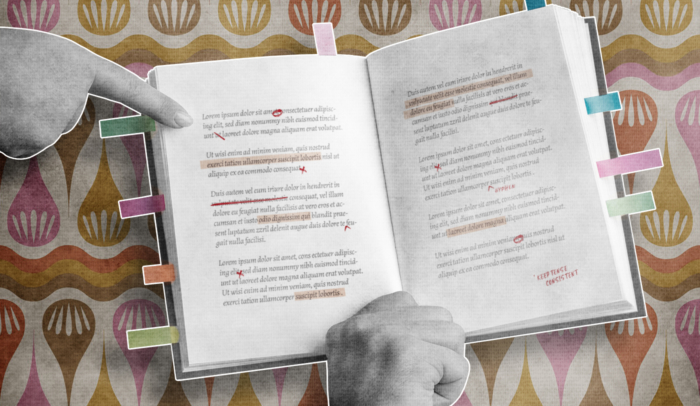Every book needs editing. The question is: what type of editing do you need for your book?
Well, it depends.
It gets confusing because there are many different types of editing, but no agreed-upon definitions for those different types in the editing process.
I’m going to fix that for you. I’ll lay out the common definitions of all the different types of editing, then explain when it’s appropriate to use each one.
Developmental Editing
(Also called: conceptual editing or manuscript appraisal.)
A developmental edit happens early in the writing process, often when an author has an idea for a book or a rough outline, but they need help bringing the pieces together.
A developmental editor looks at the big picture with your book, focusing on organization and structure more than word choice, punctuation, and grammar. They help ensure your arguments line up, reduce inconsistency, that your stories are in the right place, and that everything flows.
Are you leaving out any key details? Is there irrelevant material that needs to be cut?
These are the types of questions a developmental editor should answer for you, along with helping you fix what’s not working and amp up what’s working well in your book.
Keep in mind that developmental editors don’t do any writing or rewriting. They might make suggestions, but their job is to help you become a better writer by explaining how to organize your ideas, structure your book’s content, and transition smoothly between ideas.
They’ll help you see your book the way your readers will see it and provide feedback that is aimed at helping you craft a book people will enjoy reading.
If you’re a seasoned author or have confidence in the manuscript you’ve created, you likely don’t need to hire a developmental editor. But if you need help taking your ideas and forming them into a book, developmental editing can be a major help.
(In the Scribe Professional process, this is very similar to what you do in the Positioning and Roadmap phases.)
Evaluation Editing
(Also called: manuscript critique or structural edit.)
With an evaluation edit, a professional editor looks at your manuscript to assess structure, flow, completeness, and overall quality. The editor will usually provide you with a short memo that summarizes their key points, areas of concern, and suggestions for your book.
They’ll also mark up your manuscript at a high level, making note of any structural concerns or questions they have. Similar to a developmental editor, they’re not as focused on the finer details of your writing, but rather any big picture issues.
If you receive a glowing evaluation, your book might be ready for copyediting and proofreading.
If the editor says your book’s organization and structure need serious work, you might need a developmental editor.
If the structure is sound but your writing needs work, you might need a line edit or content edit to strengthen your manuscript.
An evaluation edit is a safeguard that keeps you from paying for later stage edits (described below) or trying to publish your book before it’s ready.
There is some overlap between developmental editing and evaluation editing, with the key difference being that you need a finished manuscript for an evaluation edit.
You can come to a developmental editor with or without a book, but if you want an evaluation editor to assess your work, you need to have a finished manuscript to show them.
Content Editing
(Also called: substantive editing or full editing.)
Whereas developmental and evaluation edits look mainly at big picture issues, a content edit is the level at which an editor also starts to dig into the words on the page.
In addition to evaluating the structure of your book, a content editor reads and carefully edits the manuscript with an eye on the completeness, flow, and construction of ideas and stories, working paragraph by paragraph and chapter by chapter.
A content editor should provide you with a paragraph-level set of markups on your manuscript, offering corrections, pointing out incomplete sections, and offering advice on smoothing the flow and construction of your chapters, sections, and subsections.
A key focus for a content edit should also be the tone and voice of your manuscript. A content editor should be aware of your target audience to ensure that the way your content comes off (tone) is a good fit for that audience, and that the writing sounds like you (voice). They help refine your language for your intended audience.
The key difference between a content edit and a line edit (two terms that are often used interchangeably) is that a content edit is not as detailed as a line edit. It exists between the high-level view of a developmental or evaluation edit, and the ground-level view that a line editor takes as they work through each line of your manuscript.
A content editor won’t move your chapters around, but they will move sections or paragraphs around within your chapters, move content to different chapters, or delete content entirely.
Think of it this way: a developmental or evaluation editor helps you build the house (the book) and figure out which rooms (chapters) should go where.
With those rooms in place, the content editor’s job is to help you arrange the furniture (sections and paragraphs) inside those rooms in a way that’s appealing.
Unlike line editors, they’re not concerned with the decorations (sentences).
Line Editing
(Also called: stylistic edit or comprehensive edit.)
As the name implies, a line editor performs a line-by-line review of your manuscript. Up to this point, the editors have worked on your manuscript at a high level—either the macro level where they consider the entire book, or the chapter and paragraph level.
The line editor jumps into the manuscript with both feet, providing the most detailed edit you can get. Notice that I didn’t say “comprehensive.” A great line editor will make your prose sing, but if your content isn’t structured properly, it won’t matter.
That’s why it’s important not to jump in with line editing before your book has the proper structure and organization in place and your content is where it needs to be.
A line editor is down in the weeds, so they’re not looking at the big picture. They’re focusing on word choice and whether each sentence has the intended impact.
Like other editors, they focus on your book’s flow, but they’re more concerned with how each word in a sentence interacts with the others and how sentences flow into each other.
Line editors point out run-on sentences, sentence fragments, and clichés. They help you clarify meaning, eliminate jargon, and ensure that each sentence sounds right in the reader’s mind.
They also push back against the natural inclination many of us have toward wordiness by tightening your sentences and helping you say in five words what you initially said in fifteen.
A line editor is not as concerned with errors, but rather the words you use to communicate with your reader. They want your writing to be short, simple, concise, and about the reader—the essential writing principles of great non-fiction.
That said, a line editor may perform the duties of a copyeditor, but it’s not a given. If you want an editor who can provide this kind of all-in-one service, clarify that desire up front.
Copyediting
When you have a finished manuscript—and I mean completely finished, not one that’s close to done or has a few gaps to fill in—it’s time to hire a copyeditor.
A copyeditor will meticulously go through your book and find the spelling, punctuation, and grammar mistakes.
That’s right—no matter how confident you are that your manuscript is mistake free, there are mistakes in there.
When you read your book out loud (which all authors should do), you’ll catch the sloppy mistakes and wording issues, but you’ll miss the stuff that copyeditors search for: small grammatical rules that native English speakers often don’t even realize exist.
There is a lot of data on this, but average people only detect about 60 percent of errors, and even professionals usually only catch about 85 percent. That’s why copyediting and the next type of editing (proofreading) should be in tandem.
Copyeditors not only find mistakes, they also check that your book follows the style guide appropriate for your genre (most books use the Chicago Manual of Style).
Even if you think having your neighbor read through your book is enough to find all the spelling, grammar, and punctuation mistakes (which it’s not), unless that neighbor is a professional copyeditor, they won’t know how to style your book correctly.
The kinds of mistakes copyeditors catch are not life threatening, but they make the difference between a professional book and one that comes across as amateur.
Proofreading
Although the terms “copyediting” and “proofreading” are often used interchangeably, they describe different processes that benefit your book in unique ways.
A proofreader takes the printed version of your book after it’s been designed and formatted (called a “proof) and gives it a final review before the book goes to print. Since it comes right before publication, proofreading is the last line of defense against errors.
You should always have your manuscript copyedited before it goes to layout, and then always have your book professionally formatted before it goes to a proofreader.
Here’s why: like a copyeditor, a proofreader looks for typos and misplaced punctuation, but also searches for layout issues like page numbering, consistency with headings, placement of tables of figures in the text, bad line or page breaks, and more.
A proofreader isn’t looking to fix your content—just correct any errors they see.
Because so much published writing lives online nowadays, many editorial teams don’t bother with proofreaders and just use copyeditors to get content ready for publication. However, many will still ask for the copy to be proofread before it’s published.
That’s why confusion exists about how copyediting and proofreading differ. If you want to break it down, here’s an easy way to remember the difference:
Copyeditors catch all the mistakes the author missed.
Proofreaders catch all the mistakes the copyeditor missed.
What Type of Editing Does Your Book Need?
Now that we’ve walked through the different types of editing, you should have a better idea which ones are appropriate for your book based on your needs as an author.
At the very least, you need to hire a professional copyeditor and proofreader to ensure readers can enjoy the book you worked hard to write without being distracted by dozens of typos.


